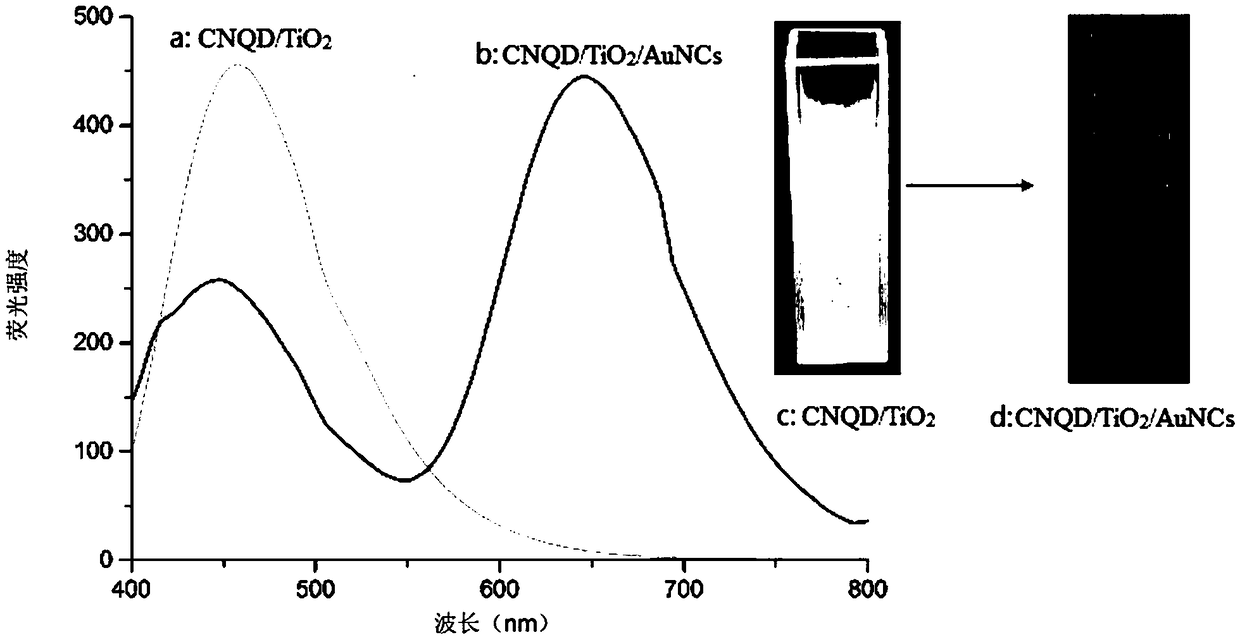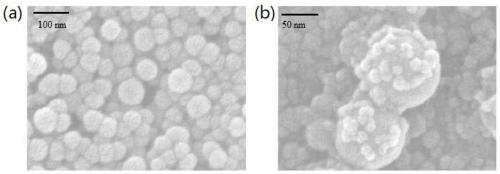Preparation method and application of ratio-type CNQDs/TiO2/AuNCs composite fluorescent microsphere
A technology of composite fluorescence and fluorescent microspheres, which is applied in the field of photochemical detection, can solve the problems of poor technical repeatability and cumbersome technical operation, and achieve the effects of improving sensitivity and specificity, expanding application range, and large specific surface area
- Summary
- Abstract
- Description
- Claims
- Application Information
AI Technical Summary
Problems solved by technology
Method used
Image
Examples
Embodiment 1
[0041] S1: Preparation of CNQDs solution;
[0042] The specific steps for preparing CNQDs are as follows: firstly, 10 g of melamine was weighed and calcined in a muffle furnace at 600 °C for 2 h. get the yellow C 3 N 4 powder; secondly, 30 mg of C 3 N 4 The powder was dissolved in 3 g PEG 200, and 1.5 g concentrated KOH (1.1 g / mL) was added; after stirring for 15 min, the solution was transferred to a reaction kettle, and reacted at 180 ° C for 16 h; after cooling to room temperature, the reaction solution was used An organic membrane with a pore size of 0.22 μm was used for suction filtration, and the collected filtrate was dialyzed in a dialysis bag with a molecular weight cut-off of 1000 for 24 hours, and the dialyzed solution was distilled to 100 mL with distilled water for use.
[0043] S2: Preparation of CNQDs / TiO 2 Ethanol solution of fluorescent microspheres;
[0044] 0.15 mL of tetrabutyl titanate was gradually added to 10 mL of ethylene glycol and kept stirring...
Embodiment 2
[0062] S1: Preparation of CNQDs solution;
[0063] The specific steps for preparing CNQDs are as follows: firstly, 10 g of melamine was weighed and calcined in a muffle furnace at 600 °C for 2 h. get the yellow C 3 N 4 powder; secondly, 30 mg of C 3 N 4 The powder was dissolved in 1.5 g PEG 200, and 0.3 g concentrated KOH (1.1 g / mL) was added; after stirring for 15 min, the solution was transferred to a reaction kettle, and reacted at 180°C for 16 h; after cooling to room temperature, the reaction solution was Suction filtration was performed with an organic membrane with a pore size of 0.22 μm, and the collected filtrate was dialyzed in a dialysis bag with a molecular weight cut-off of 1000 for 24 h, and the dialyzed solution was distilled to 100 mL with distilled water for use.
[0064] S2: Preparation of CNQDs / TiO 2 Ethanol solution of fluorescent microspheres;
[0065] 0.1 mL of tetrabutyl titanate was gradually added into 10 mL of ethylene glycol and stirred at room...
Embodiment 3
[0077] S1: Preparation of Carbon Nitride Fluorescent Quantum Dots (CNQDs)
[0078] The specific steps for preparing CNQDs are as follows: firstly, 10 g of melamine was weighed and calcined in a muffle furnace at 600 °C for 2 h. get the yellow C 3 N 4 powder; secondly, 30 mg of C 3 N 4 The powder was dissolved in 30 g PEG 200, and 3 g concentrated KOH (1.1 g / mL) was added; after stirring for 15 min, the solution was transferred to a reaction kettle, and reacted at 180 ° C for 16 h; after cooling to room temperature, the reaction solution was Suction filtration was performed with an organic membrane with a pore size of 0.22 μm, and the collected filtrate was dialyzed in a dialysis bag with a molecular weight cut-off of 1000 for 24 h, and the dialyzed solution was distilled to 100 mL with distilled water for use.
[0079] S2: Preparation of CNQDs / TiO 2 fluorescent microspheres
[0080] 0.1 mL of tetrabutyl titanate was gradually added into 50 mL of ethylene glycol and stirr...
PUM
| Property | Measurement | Unit |
|---|---|---|
| concentration | aaaaa | aaaaa |
| emission peak | aaaaa | aaaaa |
| particle diameter | aaaaa | aaaaa |
Abstract
Description
Claims
Application Information
 Login to View More
Login to View More - R&D Engineer
- R&D Manager
- IP Professional
- Industry Leading Data Capabilities
- Powerful AI technology
- Patent DNA Extraction
Browse by: Latest US Patents, China's latest patents, Technical Efficacy Thesaurus, Application Domain, Technology Topic, Popular Technical Reports.
© 2024 PatSnap. All rights reserved.Legal|Privacy policy|Modern Slavery Act Transparency Statement|Sitemap|About US| Contact US: help@patsnap.com










